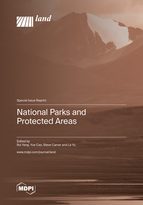National Parks and Protected Areas
A special issue of Land (ISSN 2073-445X).
Deadline for manuscript submissions: closed (31 December 2022) | Viewed by 35517
Special Issue Editors
2. Department of Landscape Architecture, School of Architecture, Tsinghua University, Beijing 100084, China
Interests: national parks and protected areas; landscape planning and design; landscape architecture history and theory
2. Department of Landscape Architecture, School of Architecture, Tsinghua University, Beijing 100084, China
Interests: national parks and protected areas; wilderness protection and rewilding; landscape planning and design
Interests: wilderness; wildland; rewilding; landscape evaluation; GIS; spatial analysis; environmental modelling; participatory GIS
Interests: land use change mapping; climate modelling; cropland mapping; uncertainty analysis
Special Issues, Collections and Topics in MDPI journals
Special Issue Information
Dear Colleagues,
The destruction and degradation of nature undermine biodiversity and human well-being. Protected areas (including national parks) represent one of the best ways to safeguard nature and preserve biodiversity for the benefit of all life on Earth. Protected areas put the focus on nature conservation while providing various types of ecosystem services and contributing to the achievement of Sustainable Development Goals (SDGs). Currently, most of the countries have some type of protected area. Many scholars have called for the expansion of the protected areas system to protect 30% or 50% (or even more) of the Earth in the next few decades.
While the protected areas system covers a vast area, involving many stakeholders and facing multiple threats, it is crucial to improve the management quality and develop innovative strategies to better realize effective conservation and sustainable development.
The purpose of this Special Issue is to invite academics and researchers to submit papers oriented to the planning and governance of national parks and protected areas. Potential topics include, but are not limited to:
- Protected areas and the post-2020 Global Biodiversity Framework;
- Climate change and protected areas;
- Public health and protected areas;
- Spatial planning and connectivity conservation of protected areas;
- Wilderness conservation and rewilding in protected areas;
- Community-based conservation and public participation in protected areas;
- Recreation opportunities in protected areas;
- Applying innovative methods, tools and technologies (e.g., remote sensing, big data analysis) in protected areas.
We look forward to receiving your contributions.
Prof. Dr. Rui Yang
Dr. Yue Cao
Dr. Steve Carver
Prof. Dr. Le Yu
Guest Editors
Manuscript Submission Information
Manuscripts should be submitted online at www.mdpi.com by registering and logging in to this website. Once you are registered, click here to go to the submission form. Manuscripts can be submitted until the deadline. All submissions that pass pre-check are peer-reviewed. Accepted papers will be published continuously in the journal (as soon as accepted) and will be listed together on the special issue website. Research articles, review articles as well as short communications are invited. For planned papers, a title and short abstract (about 100 words) can be sent to the Editorial Office for announcement on this website.
Submitted manuscripts should not have been published previously, nor be under consideration for publication elsewhere (except conference proceedings papers). All manuscripts are thoroughly refereed through a single-blind peer-review process. A guide for authors and other relevant information for submission of manuscripts is available on the Instructions for Authors page. Land is an international peer-reviewed open access monthly journal published by MDPI.
Please visit the Instructions for Authors page before submitting a manuscript. The Article Processing Charge (APC) for publication in this open access journal is 2600 CHF (Swiss Francs). Submitted papers should be well formatted and use good English. Authors may use MDPI's English editing service prior to publication or during author revisions.
Keywords
- protected areas
- national parks
- biodiversity
- conservation
- climate change
- nature-based solutions
- sustainable development goals









